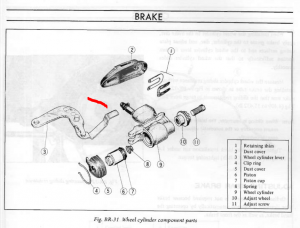I think that it might be possible for the self-adjusting mechanism to over-turn the wheel in the adjuster. I've studied it and the little arm that grabs a tooth and moves it is meant to have a certain limited travel. So that it can only grab the next tooth after certain amount of wear allows the lever's starting point to drop back to the next tooth. And the width of the arm causes it to ride on top of the teeth until the proper moment arrives. For many brake lever pulls the adjusting arm just slides back and forth on top of the adjusting wheel teeth. Until, finally, it can drop down, grab a tooth, and move it forward.
Considering the beating that brakes take when we replace the shoes it wouldn't be a surprise to find that arm malformed or worn.
Could also be that the external stop, or bumper, that determines the starting position of the external portion of the brake lever, is allowing it to drop back too far, allowing it to grab a tooth early and move it too far.
 Subscriber
Subscriber 1Points3Posts
1Points3Posts





